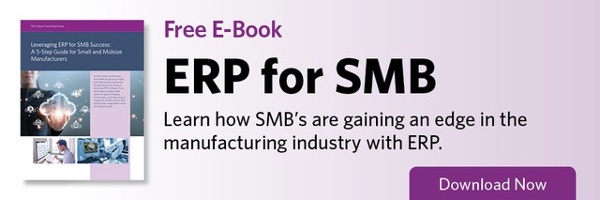In this special blog series, ERP for Small and Midsize Manufacturers, we’ll discuss how SMBs are gaining an edge in the Manufacturing industry through ERP software. From flexible deployment options to mission-critical functionality, you’ll learn what to look for to extend the value and shelf life of your next ERP system.
Small and medium-sized businesses (SMBs) must often make forward-thinking investments to reach the next phase of growth.
But whether it’s launching a new service or venturing into an emerging market, savvy SMBs know there are ways to expand your  business model without busting your budget.
business model without busting your budget.
Likewise, a modern ERP system can support both synergy and momentum in a growing organization, but like every worthwhile investment, it comes at a cost. Fortunately, modular ERP systems allow small businesses to break down walls between data siloes, integrate operations and gain valuable business insights – without exhausting capital.
Here are three ways SMB manufacturers can remain cost-effective with modular ERP.
1. Only pay for the modules you need.
As a small or medium-sized manufacturer, your needs are different from not only those of a larger enterprise but also your competitors. Modular ERP systems allow you to customize a software package right-sized for your organization. For example, if you are supported by a marketing agency or outside call center, a customer relationship management (CRM) module may not be a must-have for your company, while supply chain and resource management modules may be essential. By adopting the right solution for your business, you can consolidate your financial data, customer information, sales numbers and more into a single resource – without incurring the expense of unneeded functions.
2. Take a phased approach to implementation.
A significant portion of your software budget may be earmarked for ERP implementation. For this reason, among others, some organizations opt for a phased approach to implementation. This allows a basic ERP software package to be initially deployed and secondary features to be added in a second wave. This approach may be particularly effective for companies who would like to give their workforce an opportunity to learn the basics of the system before tackling additional complexity or for organizations who would rather split the cost over multiple quarters or fiscal years. Adopting a cloud-based ERP system that runs on a subscription model can also help keep costs in check.
3. Grow your software with your organization.
Most ERP software options have dozens of modules available, and the configuration you choose today may not be exactly what your business needs in the years ahead. A modular ERP system allows you to add modules as your business evolves and your organization grows. For instance, should your company acquire another small business, a more sophisticated bookkeeping module may be needed. Or, if you find that your company is moving into the next stage of development, such as a medical device firm now needing to comply with FDA regulations, a specific module might be required. The beauty of modular ERP is that it can help get you where you want to be.

